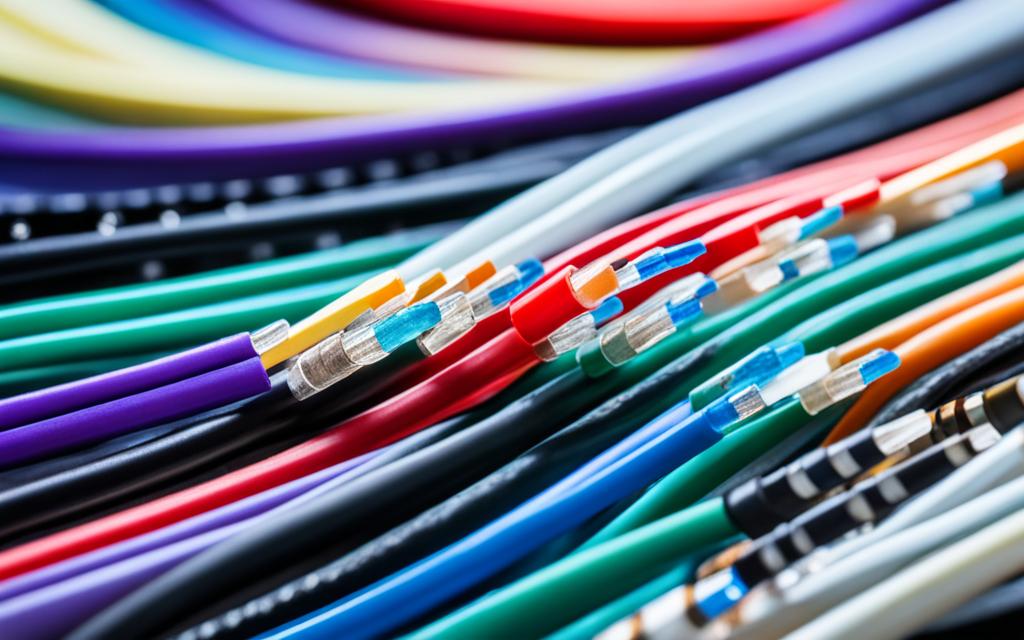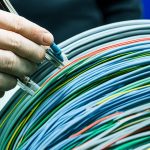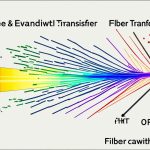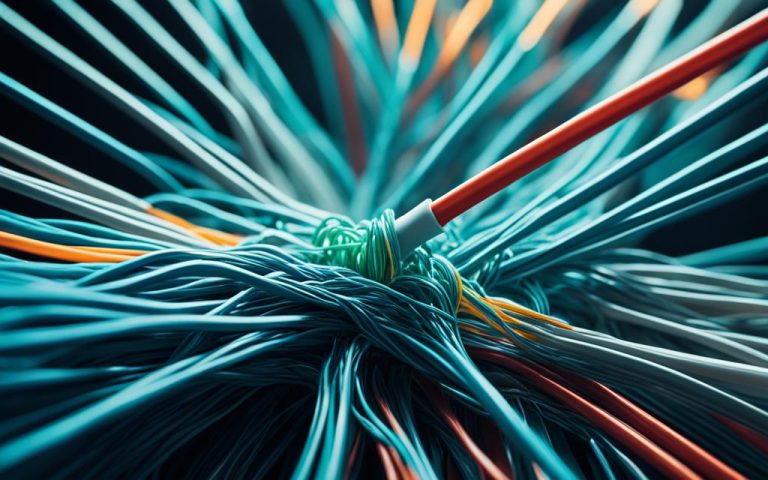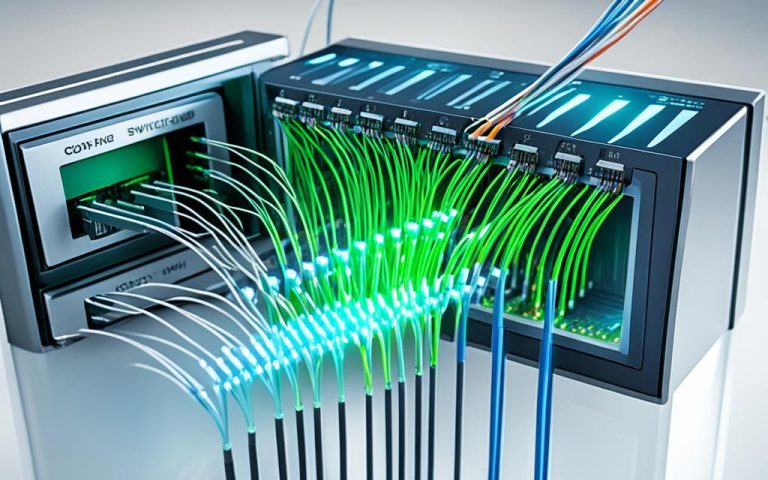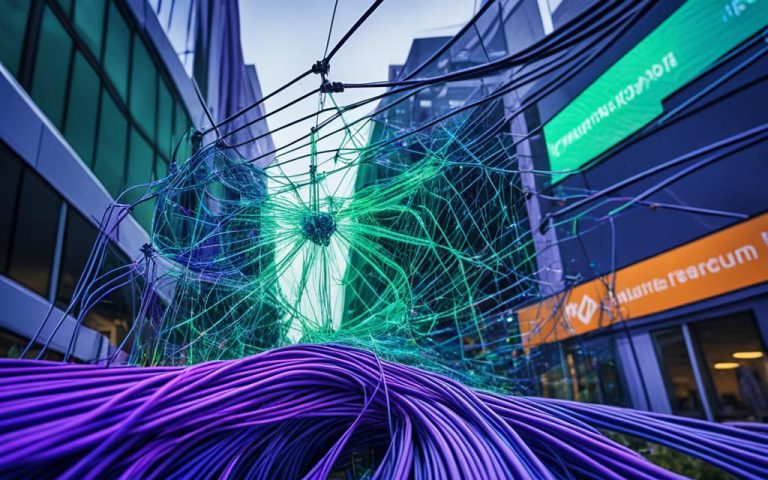Fiber optic cable types and their unique properties play a crucial role in data networking and telecommunications. Choosing the right fiber optic cable is essential to ensure fast data transmission, reliability, and optimal performance for your network.
When it comes to fiber optic cables, numerous options are available, each with its own set of characteristics and applications. Understanding the different cable types and their specific properties is key to making an informed decision for your networking needs.
Whether you’re setting up a data center, upgrading your network infrastructure, or establishing long-distance connections, this comprehensive guide will walk you through the various fiber optic cable types and help you navigate their unique features.
From single mode to multimode cables, we will explore key considerations such as network speed, distance capabilities, cable jacket requirements, and connector compatibility. Armed with this knowledge, you’ll be equipped to select the most suitable fiber optic cable type for your specific requirements.
Join us on this informative journey as we delve into the world of fiber optic cable types and unlock their unique properties.
How to Choose Fiber Optic Cable
When it comes to selecting the right fiber optic cable, there are several key considerations that you should keep in mind. By understanding these factors, you can ensure that you choose the most suitable cable for your specific application.
One of the first things to consider is the distance that the cable needs to cover. Different fiber optic cables have different transmission capabilities, with some designed for shorter distances and others capable of spanning much longer distances. The choice between singlemode and multimode fiber will depend on the network’s speed and distance requirements.
Network speed is another crucial factor to consider. Fiber optic cables are available in different types, each offering varying data transmission speeds. Multimode fiber cables are typically used for shorter distances and offer lower data transmission speeds, while singlemode fiber cables are better suited for longer distances and can support higher speeds.
The cable jacket is also an important consideration. The jacket protects the fiber optic cable and ensures its durability. It is crucial to choose a cable jacket that meets the local fire codes, especially if the cable will be running through risers or plenum spaces. Additionally, flexibility and strength under tensile load should be assessed to ensure that the cable can withstand the demands of its environment.
Moreover, it is essential to consider the connectors that will be used with the fiber optic cable. The connectors must match the ports on your network equipment to ensure a seamless and efficient connection. Pay attention to the specific type and number of fibers required by the equipment.
Lastly, considering the cost and future-proofing is crucial. While it’s important to select a cable that meets the current needs of your network, it’s also wise to anticipate future growth and technological advancements. Opting for a cable that offers room for scalability can save you the hassle and expense of replacing it in the near future.
By carefully evaluating factors such as distance, network speed, cable jacket, connectors, cost, and future-proofing, you can confidently choose the right fiber optic cable for your network requirements.
Choosing the right fiber optic cable involves careful consideration of various factors, including network speed, distance, cable jacket, and connectors. By selecting the most suitable cable for your specific application, you can ensure optimal performance and reliability.
Key Considerations for Choosing Fiber Optic Cable:
- Distance: Determine the transmission distance required for your network.
- Network Speed: Consider the data transmission speed needed for your network.
- Cable Jacket: Choose a jacket that meets local fire codes and offers the necessary flexibility and strength.
- Connectors: Ensure connectors match the ports on your network equipment.
- Cost and Future-Proofing: Consider both the immediate cost and the potential for scalability in the future.
By taking these key considerations into account, you can make an informed decision and choose the fiber optic cable that is best suited for your networking needs.
| Fiber Optic Cable Consideration | Key Factors to Consider |
|---|---|
| Distance | Transmission distance requirements |
| Network Speed | Data transmission speed needed |
| Cable Jacket | Meets local fire codes, flexibility, and strength |
| Connectors | Match with ports on network equipment |
| Cost and Future-Proofing | Consider immediate cost and scalability |
Network Speed and Distance
The choice between multimode and singlemode fiber optic cables should be based on the network design and the required network speed and distance.
Multimode fiber is suitable for short distances (less than 300 meters) and can be cost-effective. It is commonly used in local area networks (LANs), data centers, and short-range applications.
Singlemode fiber is preferred for longer distances and higher data transmission speeds. It is typically used in wide area networks (WANs), long-haul applications, and telecommunications networks.
The range of multimode fiber depends on its OM rating, which indicates the quality and performance of the fiber. The OM rating is based on the bandwidth and modal dispersion characteristics of the fiber. Generally, higher OM ratings offer better performance and longer transmission distances.
On the other hand, singlemode fiber is capable of transmitting data over long distances up to 100km. It has a smaller core size and enables the transmission of higher wavelengths, allowing for higher signal quality and longer reach.

| Fiber Optic Cable Type | Description | Distance |
|---|---|---|
| Multimode Fiber | Designed for short-range applications | Less than 300 meters |
Multimode Fiber OM Ratings
|
||
| Singlemode Fiber | Designed for long-range applications | Up to 100km |
Singlemode Fiber Types
|
||
Cable Jacket
When it comes to selecting a fiber optic cable, one important factor to consider is the cable jacket. The cable jacket serves as the outer protective layer of the cable, providing insulation and safeguarding the internal components from external elements. It plays a crucial role in maintaining the cable’s performance and protecting it from damage.
All indoor fiber optic cables must meet local fire codes and regulations. The cable jacket should be rated accordingly if the cable is intended to be installed in riser or plenum spaces. These spaces often require cables with specific fire ratings to ensure safety. The fire rating indicates the cable’s ability to resist and prevent the spread of fire.
The flexibility of the cable jacket is another important aspect to consider. Optimum flexibility allows for easier installation and routing of the cable, especially in tight spaces or areas with complex cable runs. A flexible jacket ensures that the cable can be maneuvered around corners, bends, and obstacles without compromising its performance or integrity.
Tensile strength is another consideration when evaluating the cable jacket. The jacket should be designed to withstand the mechanical stresses and strains placed on the cable during installation and operation. It should have sufficient strength to resist pulling forces and protect the delicate fiber optics inside.
Color coding of the cable jacket is often used to differentiate between different types of optical fibers in a cable. For example, a yellow jacket is typically associated with single-mode fiber, while an orange jacket indicates multimode fiber. This color coding aids in identification during installation and maintenance tasks.
Jacket Properties:
- Fire rating according to local regulations
- Flexibility for easy installation
- Tensile strength to withstand mechanical stresses
- Color coding for fiber identification
Choosing the right cable jacket is essential to ensure the cable’s compliance with fire regulations, proper installation, and optimal performance. By considering factors such as fire rating, flexibility, tensile strength, and color coding, you can select a fiber optic cable with a suitable jacket that meets your specific requirements.
| Jacket Property | Description |
|---|---|
| Fire Rating | Indicates the cable’s ability to resist and prevent the spread of fire |
| Flexibility | Affects the ease of installation and routing of the cable |
| Tensile Strength | Determines the cable’s ability to withstand pulling forces |
| Color Coding | Aids in identifying different types of optical fibers in the cable |
Connectors
The choice of connectors for fiber optic cables is crucial in ensuring seamless connectivity between your network equipment. Understanding the compatibility between cable connectors and network equipment ports is key to achieving optimal performance and reliability.
For instance, if your network equipment features multi-fiber MTP ports, you will need fiber optic cables with the required number of fibers to enable connectivity. It’s important to check the specifications of your equipment and select the appropriate connectors accordingly.
In certain high-speed applications like 40GbE or 100GbE, Active Optical Cables (AOCs) offer an integrated solution by combining the optical fiber cable and transceivers into a single cable. This simplifies installation and maintenance, providing a streamlined solution for high-speed data transmission.
When choosing connectors, it’s crucial to ensure compatibility not only with your network equipment but also with the type of fiber optic cable being used. Different types of connectors, such as LC, SC, and ST, may be suitable for different cables and applications.
Factors to Consider when Choosing Connectors:
- Port Compatibility: Ensure the connectors match the ports on your network equipment.
- Cable Type: Consider the type of fiber optic cable being used and select connectors accordingly (e.g., LC connectors for single mode cables, SC connectors for multimode cables).
- Application Requirements: Evaluate the specific needs of your application, such as data speed, distance, and environmental conditions, to select connectors that meet these requirements.
- Quality and Reliability: Choose connectors that are known for their quality and reliability to ensure consistent performance and minimize the risk of signal loss or disruptions.
By selecting the right connectors and ensuring compatibility with your network equipment and fiber optic cables, you can create a robust and efficient network infrastructure.
Image:
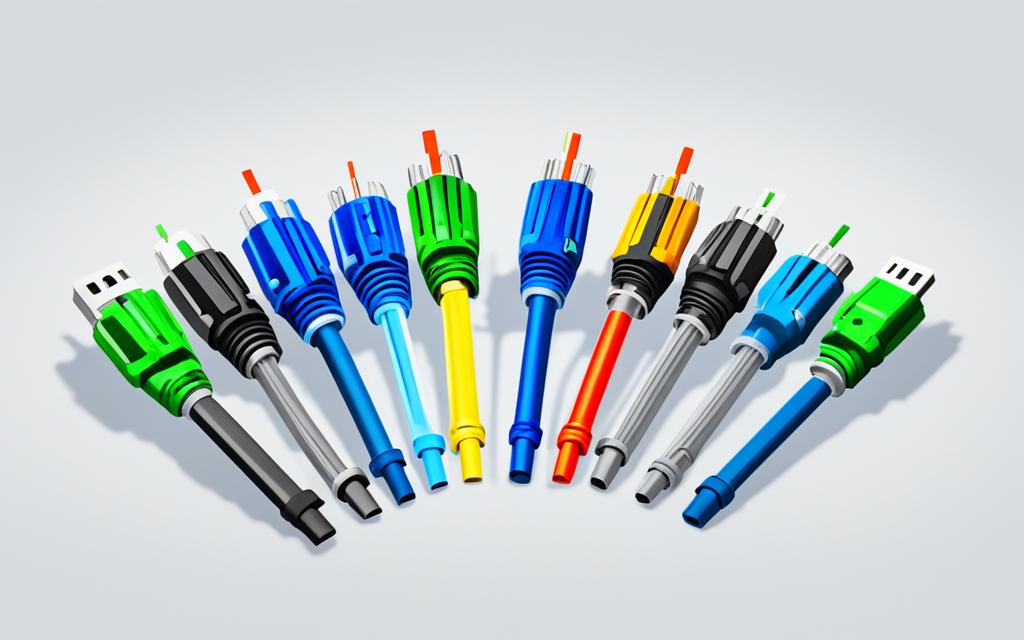
| Connector Type | Description |
|---|---|
| LC Connector | A small, snap-in connector commonly used in single mode and multimode fiber optic cables. It offers low insertion loss and excellent stability. |
| SC Connector | A push-pull connector widely used in both single mode and multimode fiber optic cables. It provides good stability and ease of installation. |
| ST Connector | A bayonet-style connector often used in multimode fiber optic cables. It features a twist-to-lock mechanism for secure connections. |
| MTP Connector | A high-density connector commonly used in high-speed data transmission applications. It allows for multiple fibers to be connected simultaneously. |
Single Mode Fiber Optic Cables
Single mode fiber optic cables are specifically designed for long-distance data transmission. They feature a narrow core, which allows for the precise delivery of signals over extended distances. Made from a single glass fiber strand, these cables offer superior performance and reliability.
One of the key advantages of single mode fiber optic cables is their ability to transmit data up to 100km without any signal degradation. This makes them ideal for applications that require data transmission over longer distances, such as telecommunications networks and backbone infrastructure.
Single mode fiber cables are classified into two types: OS1 and OS2. OS1 cables are designed for indoor use, while OS2 cables are more suitable for outdoor and rugged environments. OS2 cables have a higher throughput and are built with a loose-tube construction, providing increased flexibility and durability.
In summary, single mode fiber optic cables offer high-performance data transmission capabilities over long distances. With their narrow core and classification into OS1 and OS2 types, these cables provide the reliability and flexibility required for demanding networking applications.
Multimode Fiber Optic Cables
Multimode fiber optic cables offer a cost-effective solution for shorter distance data transmission. These cables have a larger core diameter compared to single mode fiber cables, allowing for the transmission of multiple streams of data.
Multimode cables are classified into different types, each offering different performance capabilities and maximum bandwidth:
- OM1: This type of multimode fiber optic cable is designed for legacy applications and supports data transmission of up to 10 Gigabits per second (Gbps) over a distance of 33 meters.
- OM2: With improved bandwidth, OM2 cables can transmit data at speeds of up to 10 Gbps over a distance of 82 meters.
- OM3: OM3 cables are designed for higher bandwidth applications and can transmit data at speeds of up to 10 Gbps over a distance of 300 meters.
- OM4: These cables provide higher data transmission speeds of up to 40 Gbps over a distance of 400 meters, making them suitable for high-performance networks.
- OM5: The newest standard in multimode fiber optic cables, OM5 cables, utilize short wavelength division multiplexing (SWDM) technology to support higher bandwidth at longer distances. They can transmit data at speeds of up to 100 Gbps over a distance of 150 meters.
Here is a comparison table of the different multimode fiber optic cable types:
| Type | Maximum Bandwidth | Maximum Distance |
|---|---|---|
| OM1 | 10 Gbps | 33 meters |
| OM2 | 10 Gbps | 82 meters |
| OM3 | 10 Gbps | 300 meters |
| OM4 | 40 Gbps | 400 meters |
| OM5 | 100 Gbps | 150 meters |
OM5 cables are ideal for future-proofing your network and supporting higher bandwidth requirements. With the ability to transmit data at faster speeds over longer distances, OM5 cables are highly versatile for various applications.
Conclusion
Choosing the right fiber optic cable is essential for optimizing your network’s performance and reliability. Fiber optic cables offer numerous advantages over traditional copper cables, making them the preferred choice for data networking and telecommunications. Their faster data transmission speeds, higher bandwidth capacity, and longer transmission distances ensure efficient and reliable connectivity. Additionally, fiber optic cables are immune to electromagnetic interference, providing a secure and stable network environment.
Not only do fiber optic cables outperform copper cables, but they also offer other benefits. They are lighter and more environmentally friendly, contributing to a greener infrastructure. Their lightweight design makes installation and maintenance easier, saving time and resources.
By understanding the different types of fiber optic cables and their unique properties, you can choose the right cable for your specific networking needs. Consider factors such as network speed, distance, cable jacket, and connectors to ensure compatibility and optimal performance. Whether you require the longer distances and higher speeds provided by single mode fiber optic cables, or the cost-effective solution of multimode fiber optic cables for shorter distances, the right choice will enhance your network’s capabilities.
Investing in fiber optic cables is a long-term solution that future-proofs your network, ensuring scalability and adaptability to evolving technologies. With their numerous advantages, fiber optic cables are the backbone of modern telecommunications and data networking, empowering businesses and individuals with enhanced connectivity and reliable communication.
FAQ
What are the benefits of fiber optic cables?
Fiber optic cables offer benefits such as fast data transmission, thin and lightweight design, long signal range, immunity to electromagnetic interference, higher bandwidth capacity, and increased reliability and security.
How do I choose the right fiber optic cable?
When choosing a fiber optic cable, consider factors such as network speed, distance, cable jacket, and connectors. Determine the specific requirements of your application, consider cost and future-proofing, and ensure compatibility between the cable connectors and network equipment ports.
What is the difference between multimode and single mode fiber optic cables?
Multimode fiber cables have a larger core diameter and are suitable for shorter distances, while single mode fiber cables have a narrow core and are designed for longer-distance data transmission.
What is the range of multimode and single mode fiber optic cables?
The range of multimode fiber depends on its OM rating, while single mode fiber can transmit data up to 100km.
How should I choose the cable jacket for fiber optic cables?
When selecting a fiber optic cable, consider the cable jacket properties such as meeting local fire codes, flexibility, strength under tensile load, and color coding for indicating the type of optical fiber in the cable.
How do I choose the right connectors for fiber optic cables?
The choice of connectors for fiber optic cables is typically dictated by the ports on your network equipment. Ensure compatibility between the cable connectors and network equipment ports, and consider using Active Optical Cables (AOCs) for specific applications.
What are the types of single mode fiber optic cables?
Single mode fiber optic cables are classified into OS1 and OS2 types, with OS2 cables being more suitable for outdoor and longer distance use. They have higher throughput and are built in a loose-tube construction for increased flexibility and durability.
What are the types of multimode fiber optic cables?
Multimode fiber optic cables are classified into OM1, OM2, OM3, OM4, and OM5 types, with each type offering different performance capabilities and maximum bandwidth. OM5 cables, the newest standard, make use of short wavelength division multiplexing for increased support of higher bandwidth.

